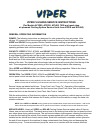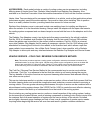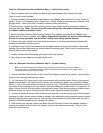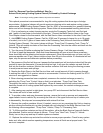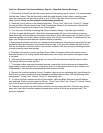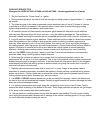Cold Car / Reverse Flow Service Method: Step 3a –
Solvent Flush (using Cooling System Cleaner) Followed by Coolant Exchange
Note: If not using a cooling system cleaner, skip to the next section.
This optional procedure is recommended for long-life cooling systems that show signs of sludge
accumulation. A chemical cleaner will provide maximum cleaning action and restore cooling system
performance. VIPER Cooling System Cleaner, Part No. 5090, is recommended for a powerful cleaning
action and will not damage the cooling system. Please follow all recommended handling instructions.
1. Prior to performing a coolant cleaning service, empty the Processing Tank of all used fluid and
add 1 gallon of clean water to the bottom of the tank. Connect the Black Service Hose to the Cross
Flow Adapter closest to the thermostat, with the Red Service Hose connected to the other Cross Flow.
2. Add VIPER Cooling System Cleaner, Part No. 5090 (use 32 ounces of cleaner for up to 18 quarts
of coolant), into to the 1 gallon of clean water in the Processing Tank (follow all directions on VIPER
Cooling System Cleaner). Set control valves as follows: “Pump From” Processing Tank; “Pump To”
Vehicle. (This will enable circulation of fluid from the Processing Tank into the vehicle and back into the
Processing Tank again.)
3. Turn the pump ON while monitoring the System Pressure Gauge. It will take approximately
15-18 psi to open the thermostat. (Note that some thermostats will open at much lower pressures –
these most likely will be defective and require replacement. Other thermostats may not open until the
pressure reaches over 20 psi.) Never introduce more than 25 psi to the vehicle. If a thermostat will not
open, stop the process and determine problem before proceeding.
4. The pressure of the fluid will drop as it passes the thermostat and will circulate at about half the rate
required to open the thermostat. If pressure builds too high, it will open the radiator cap and fluid will
flow into the overflow container. Monitor the overflow container fluid level during the cleaning process
to avoid pressure issues and spillage.
5. Monitor the Sight Glass in the Red Service Hose until a small amount of fluid is passing through.
A working flow rate of 3 to 4 quarts a minute is recommended. Continue the flushing action for 20-30
minutes or as suggested on cleaner.
6. When cleaning process has been completed, commence the coolant exchange process by
switching the “Pump From” Control Valve so that it now indicates: “Pump From” New Tank.
Throughout the service, monitor the sight glass. When all cleaner solution/old coolant mixture
has been forced out of cooling system and replaced by new coolant, the coolant exchange process
is complete.
7. After viewing new coolant in sight glass, turn pump OFF and disconnect the Red Service Hose.
The vehicle will be full of new coolant.
8. To provide a clean and easy disconnect process, reverse the hook-up process and reassemble
upper radiator hose to vehicle. By vacuuming the fluid out of the upper hose and top of radiator prior
to disassembly, this step can be accomplished with minimal fluid loss.
9. Remove the overflow container lid and, if needed, vacuum out any remaining dirty fluid or cleaning
solution utilizing the flexible pick up tube (included with unit) attached to the Black Service Hose. Use
the following valve arrangement: “Pump From” Vehicle; “Pump To” Processing Tank.
10. To fill the overflow container and top-off the radiator, utilize the Black Service Hose with flexible
tube attached. Position control valves as follows: “Pump From” New Tank; “Pump To” Vehicle.
Slowly turn on the pump and top off vehicle system as needed.
11. Replace the radiator cap and start the vehicle to ensure proper operation. Check for any system
leaks and, after vehicle reaches operating temperature, ensure all fluids are at proper levels. The
service is complete.



